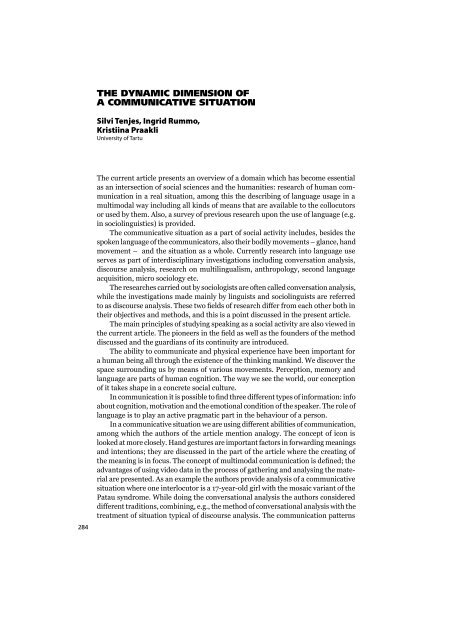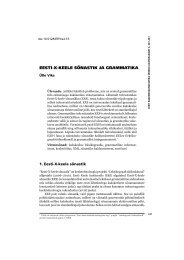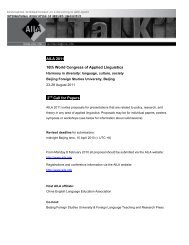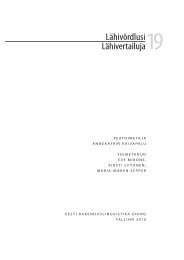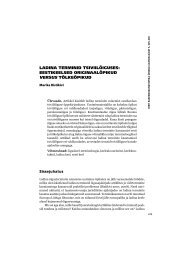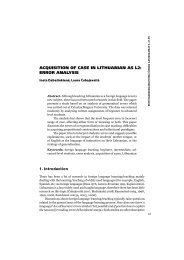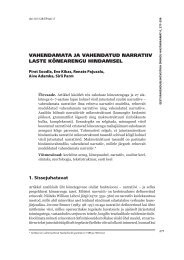View - Eesti Rakenduslingvistika Ãhing
View - Eesti Rakenduslingvistika Ãhing
View - Eesti Rakenduslingvistika Ãhing
You also want an ePaper? Increase the reach of your titles
YUMPU automatically turns print PDFs into web optimized ePapers that Google loves.
THE DYNAMIC DIMENSION OF<br />
A COMMUNICATIVE SITUATION<br />
Silvi Tenjes, Ingrid Rummo,<br />
Kristiina Praakli<br />
University of Tartu<br />
284<br />
The current article presents an overview of a domain which has become essential<br />
as an intersection of social sciences and the humanities: research of human communication<br />
in a real situation, among this the describing of language usage in a<br />
multimodal way including all kinds of means that are available to the collocutors<br />
or used by them. Also, a survey of previous research upon the use of language (e.g.<br />
in sociolinguistics) is provided.<br />
The communicative situation as a part of social activity includes, besides the<br />
spoken language of the communicators, also their bodily movements – glance, hand<br />
movement – and the situation as a whole. Currently research into language use<br />
serves as part of interdisciplinary investigations including conversation analysis,<br />
discourse analysis, research on multilingualism, anthropology, second language<br />
acquisition, micro sociology etc.<br />
The researches carried out by sociologists are often called conversation analysis,<br />
while the investigations made mainly by linguists and sociolinguists are referred<br />
to as discourse analysis. These two elds of research differ from each other both in<br />
their objectives and methods, and this is a point discussed in the present article.<br />
The main principles of studying speaking as a social activity are also viewed in<br />
the current article. The pioneers in the eld as well as the founders of the method<br />
discussed and the guardians of its continuity are introduced.<br />
The ability to communicate and physical experience have been important for<br />
a human being all through the existence of the thinking mankind. We discover the<br />
space surrounding us by means of various movements. Perception, memory and<br />
language are parts of human cognition. The way we see the world, our conception<br />
of it takes shape in a concrete social culture.<br />
In communication it is possible to nd three different types of information: info<br />
about cognition, motivation and the emotional condition of the speaker. The role of<br />
language is to play an active pragmatic part in the behaviour of a person.<br />
In a communicative situation we are using different abilities of communication,<br />
among which the authors of the article mention analogy. The concept of icon is<br />
looked at more closely. Hand gestures are important factors in forwarding meanings<br />
and intentions; they are discussed in the part of the article where the creating of<br />
the meaning is in focus. The concept of multimodal communication is dened; the<br />
advantages of using video data in the process of gathering and analysing the material<br />
are presented. As an example the authors provide analysis of a communicative<br />
situation where one interlocutor is a 17-year-old girl with the mosaic variant of the<br />
Patau syndrome. While doing the conversational analysis the authors considered<br />
different traditions, combining, e.g., the method of conversational analysis with the<br />
treatment of situation typical of discourse analysis. The communication patterns


